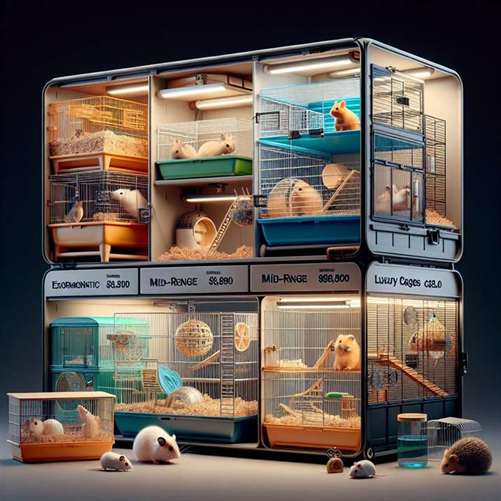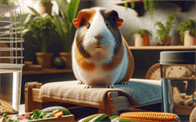Best Small Mammal Pet Cages for Every Budget
Introduction
When it comes to welcoming a furry friend into your home, one of the first considerations is finding the right habitat for them. Small mammal pet cages play a crucial role in ensuring your pet’s safety, comfort, and happiness. With the rise in popularity of small mammals as household pets—like hamsters, guinea pigs, and rabbits—understanding how to choose the perfect cage has never been more essential.
Recent studies have shown that a well-designed cage can significantly improve the quality of life for small mammals, making it a hot topic among pet owners. With various options available, ranging from budget-friendly to high-end luxury cages, knowing what to look for can be overwhelming. This guide aims to break down everything you need to know about small mammal pet cages to help you make an informed decision.
In this article, you will discover:
- The definition and significance of small mammal pet cages.
- Various types of cages available on the market.
- Factors to consider when selecting a cage for your small mammal.
- A breakdown of the best options for every budget.
- Maintenance tips for keeping your pet’s cage clean and comfortable.
So, whether you’re a seasoned pet owner or new to the world of small mammals, this guide will help you navigate the maze of options and find the ideal cage for your beloved pet. Explore our main page for more pet care tips!
What are Small Mammal Pet Cages?
Definition
Small mammal pet cages are specially designed enclosures intended to house small animals such as hamsters, guinea pigs, gerbils, rabbits, and even ferrets. These cages are crafted to provide a safe, comfortable, and stimulating environment for your pet. Key features often include ventilation, adequate space for movement, and areas for nesting or hiding.
Historical Context
The concept of housing small mammals has evolved significantly over the years. In the past, most small pets were kept in simple, confined spaces, which often lacked the necessary comfort and stimulation. However, as understanding of animal welfare has developed, the focus has shifted towards creating more enriched environments.
- 1970s-1980s: The introduction of wire cages with multiple levels began to emerge, allowing for increased space.
- 1990s: As the pet industry grew, specialized cages catering to specific species were developed, focusing on the unique needs of each animal.
- 2000s-Present: The trend has moved towards larger, more complex cages that mimic natural habitats, providing more enrichment for pets.
The Importance of Small Mammal Pet Cages
Over the years, the importance of having a suitable cage has become clear. A well-structured habitat not only keeps your pet secure but also encourages healthy behaviors. Here are a few reasons why investing in the right small mammal pet cage is crucial:
- Safety: A properly designed cage prevents escapes and keeps pets safe from household hazards.
- Comfort: A spacious and well-ventilated cage can help reduce stress and enhance your pet’s overall well-being.
- Stimulation: Many cages today come with toys and tunnels, promoting physical activity and mental stimulation.
Small Mammal Pet Cages in the Context of Pet Care
In the realm of pet care, the importance of small mammal pet cages cannot be overstated. They serve as the foundation for your pet’s living environment and can significantly impact their health and happiness.
Key Players or Contributors
Several notable brands have contributed to the evolution of small mammal pet cages. Companies like Kaytee, Ferplast, and Midwest Homes for Pets have been at the forefront, creating innovative designs that prioritize pet welfare.

Types of Small Mammal Pet Cages
When shopping for small mammal pet cages, you’ll encounter various types, each tailored to different species and lifestyles:
1. Wire Cages
Wire cages are popular for small mammals like hamsters and guinea pigs. They offer excellent ventilation and visibility, allowing for easy interaction. Some key features include:
- Multi-level platforms: Great for climbing and exploration.
- Easy access: Most have large doors for effortless cleaning.
2. Plastic Cages
These cages are often lightweight and easier to clean. They are ideal for small pets like hamsters and mice. Benefits include:
- Solid bottom: Prevents bedding from spilling and is easier to maintain.
- Customizable: Many come with modular designs, allowing you to expand or rearrange as needed.
3. Glass Aquariums
While traditionally used for fish, glass aquariums can be excellent for certain small mammals like dwarf hamsters. They offer:
- Visibility: A clear view of your pet.
- Escape-proof: The solid structure keeps pets safe.
4. Cage and Pen Combinations
For larger pets like rabbits, a cage and pen combination allows for both secure sleeping areas and ample space to roam. Features often include:
- Expandable space: You can set up larger living areas as needed.
- Ease of access: Many have removable roofs for easy handling.
5. Outdoor Cages
If you want your small mammal to enjoy the great outdoors, consider outdoor cages. These are designed to be secure and weather-resistant, allowing your pet to experience fresh air while being protected from predators.
Factors to Consider When Choosing Small Mammal Pet Cages
Selecting the right cage involves more than just picking a pretty design. Here are some essential factors to consider:
Size
The size of the cage should correspond to your pet’s needs. For example:
- Hamsters: A minimum of 24” x 12” for a single hamster.
- Guinea pigs: At least 30” x 36” for a pair.
Height
Vertical space is crucial for climbing species. Ensure the cage has multiple levels or sufficient height for your pet to explore.
Material
Choose a cage made from safe, non-toxic materials. Wire cages should have a coating that prevents rusting, while plastic cages should be sturdy and easy to clean.
Ventilation
Adequate airflow is vital for your pet’s health. Ensure the cage has enough openings to allow for proper ventilation.
Accessories
Consider whether the cage comes with necessary accessories like food dishes, water bottles, and toys. Some cages offer built-in features that can save you money in the long run.
Best Small Mammal Pet Cages for Every Budget
Now that we’ve covered the essentials, let’s dive into some of the best small mammal pet cages available across different price ranges.
Budget-Friendly Options (Under $50)
- Kaytee My First Home Small Animal Habitat
- Price: $49.99
- Features: A spacious design ideal for hamsters and gerbils, with a removable bottom for easy cleaning.
- Midwest Critter Nation
- Price: $49.99
- Features: Two levels, removable plastic trays, and a large front door for easy access.
Mid-Range Options ($50 – $150)
- Living World Deluxe Habitat
- Price: $89.99
- Features: A multi-level design with a balcony and removable bottom for easy maintenance, perfect for rabbits.
- Ferplast Krolik 140 Rabbit Cage
- Price: $129.99
- Features: Spacious interior with multiple levels, ideal for larger rabbits, includes accessories.
Premium Options ($150+)
- Critter Nation Double Unit
- Price: $189.99
- Features: Double-decker design suitable for multiple small mammals, includes ramps and removable trays for cleaning.
- Oxbow Enclosure for Small Animals
- Price: $299.99
- Features: Customizable layout and ample space for larger breeds, designed with your pet’s comfort in mind.
Maintenance Tips for Small Mammal Pet Cages
Keeping your pet’s cage clean is essential for their health and happiness. Here are some tips:
- Regular Cleaning: Aim to clean the cage at least once a week, including changing bedding and wiping down surfaces.
- Spot Cleaning: Daily removal of soiled bedding can help maintain hygiene.
- Wash Accessories: Clean food dishes, water bottles, and toys regularly to prevent bacteria buildup.
- Check for Damage: Regularly inspect the cage for any wear and tear that could compromise your pet’s safety.
Conclusion
In summary, choosing the right small mammal pet cages is fundamental to ensuring your pet’s comfort and happiness. By considering factors such as size, material, and ventilation, you can find a cage that meets your pet’s needs and fits your budget. With a plethora of options available, you have the flexibility to select a cage that enhances your pet’s life while making it easy for you to care for them.
Whether you’re on a tight budget or willing to splurge, there’s a perfect cage out there for your small mammal. Remember, a well-chosen cage serves as more than just a home—it provides a sanctuary for your furry friend to thrive. For more tips on caring for your small mammal pets, check out our resource on small mammal pet care. Happy pet parenting!
Resource Links:
- reddit.com: … Pet’s Best was for our puppy and most affordable option, Embrace … every animal. I have two beagles and even though they are siblings …
- forums.crateentertainment.com: … So, with all the forum changes and stuff, I decided to roll all my builds into a single thread + include guide of sorts and make it a pdf …
- reddit.com: … I was thinking more or less a hamster or a rat. Much smaller than the domestic cat or dog but I will need to keep toys, the cage and food in …




0 Comments